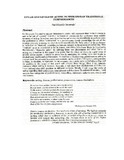| dc.description.abstract | In this paper, I intend to support Schechner's (1988:197) argument that "to be in trance is not to be out of control", and that in trance or possession the performer does exhibit elements of acting. Schechner mentions that two processes are indentifiable in performance: the performer is either "subtracted" in a performance closely resembling the art of the shaman who acts in ecstasy or what Jerzy Grotowski calls the "holy actor", or the performer is "added to" or "doubled", according to Antonin Artaud, in the process of performing. This "doubled" actor is considered to be in trance, something Schechner likens to Constantin Stanislavski's "character actor". In defining these two phenomena and other forms of acting, my intention in this paper is to prove that the whole of Africa is a gold mine of artistic performances. I intend to prove this by analyzing the acting styles and levels in Zimbabwean traditional performances. In traditional Zimbabwean performances, acting is realized in different social functions and contexts. In the contexts of this paper, acting means to feign, to simulate, to represent, to impersonate. (E.T. Kirby 1972 3) Defining acting and instances where acting is realized. Secondly, I will show how Zimbabwean societies use these define/identified qualities in different contexts. Thirdly, I will judge the levels of acting regarding their seriousness, commitment and functions. To achieve these aims, I will analyze four categories of performances, storytelling, childrens's make-believe, rituals and ceremonies. | en_US |

